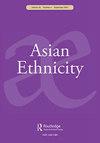重新协商多元种族主义:新加坡新移民族群认同的基层融合
IF 0.8
Q3 ETHNIC STUDIES
引用次数: 2
摘要
本文通过对新加坡的融合和归化过程的研究,探讨了新加坡政府如何在其人口中接受文化多元化的双重挑战,同时也形成了共同的民族认同。采用本尼迪克特·安德森的“绑定序列”概念,它认为新加坡国家已经发展了一个多种族主义的框架,通过三个序列或集体身份来想象新加坡民族。首先,华人、马来人、印度人和其他(CMIO)类别将个人组织成具有明确文化身份的群体。其次,CMIO类别构成了多元文化新加坡民族的固定形象。第三,作为新加坡人需要一种接受CMIO结构所代表的文化差异的精神。然而,这种自上而下的多元文化国家的想象越来越受到新公民的挑战,这些新公民体现了他们自己种族和国家身份的另类想象,这引发了对新加坡多元种族主义持续有效性的质疑。本文章由计算机程序翻译,如有差异,请以英文原文为准。
Renegotiating multiracialism: the grassroots integration of new migrants’ ethnic identities in Singapore
ABSTRACT Through a study of Singapore’s integration and naturalisation processes, this paper examines how the Singaporean state has negotiated the twin challenges of embracing cultural pluralism in its population while also forming a common national identity. Employing Benedict Anderson’s conception of ‘bound serialities’, it argues that the Singaporean state has developed a framework of multiracialism to imagine the Singaporean nation through three serialities or collective identities. First, the Chinese, Malay, Indian and Other (CMIO) categories organise individuals into groups that have clear cultural identities. Second, the CMIO categories constitute a fixed image of the multicultural Singaporean nation. Third, being Singaporean requires an ethos of accepting the cultural differences that the CMIO structure represents. However, such a top-down imagining of the multicultural nation is increasingly challenged by the arrival of new citizens who embody alternative imaginings of their own ethnic and national identities, raising questions about the continued effectiveness of Singapore’s multiracialism.
求助全文
通过发布文献求助,成功后即可免费获取论文全文。
去求助
来源期刊

Asian Ethnicity
PHYSIOLOGY-
CiteScore
2.80
自引率
6.20%
发文量
27
期刊介绍:
In the twenty-first century ethnic issues have assumed importance in many parts of the world. Until recently, questions of Asian ethnicity and identity have been treated in a balkanized fashion, with anthropologists, economists, historians, political scientists, sociologists and others publishing their studies in single-discipline journals. Asian Ethnicity provides a cross-disciplinary, international venue for the publication of well-researched articles about ethnic groups and ethnic relations in the half of the world where questions of ethnicity now loom largest. Asian Ethnicity covers any time period, although the greatest focus is expected to be on the twentieth and twenty-first centuries.
 求助内容:
求助内容: 应助结果提醒方式:
应助结果提醒方式:


